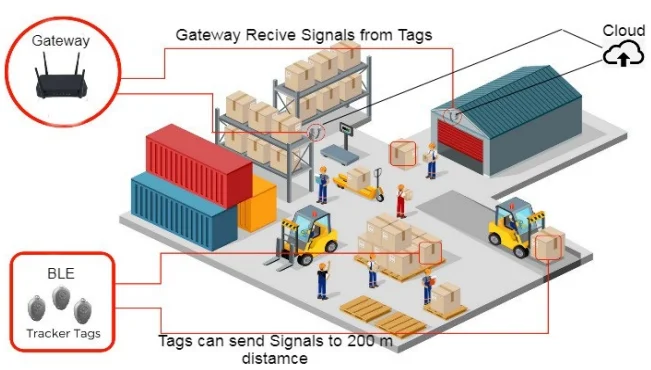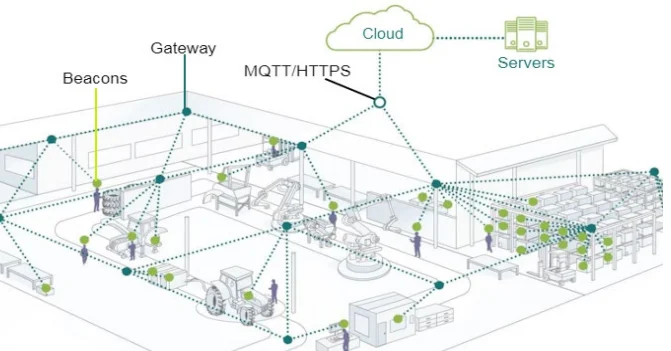Intelligent BLE Technology: Enhancing Construction
Bluetooth Low Energy (BLE) technology has numerous applications in the realm of Intelligent Construction, offering various benefits in terms of connectivity, data collection, and automation.

Here are some key Applications and Advantages of BLE in Intelligent Construction:
- Equipment and Asset Tracking: BLE beacons can be attached to construction equipment, tools, and materials. These beacons can communicate with smartphones or tablets, allowing construction managers to track the location and status of assets in real-time. This information helps prevent loss, theft, and enables efficient asset management.
- Indoor Positioning: BLE technology can provide accurate indoor positioning within construction sites, even in areas with poor GPS reception. This capability is invaluable for tracking the movement of workers, equipment, and materials within large and complex construction projects.
- Worker Safety: Wearable BLE devices or beacons can be integrated into workers’ gear or badges to monitor their movements and location on the construction site. In emergencies, this technology can help quickly locate and assist workers, enhancing overall safety.
- Proximity-based Access Control: BLE-enabled access control systems can be used to secure specific areas within the construction site. Authorized personnel can gain access through their smartphones or wearable BLE devices, reducing the need for traditional key-based systems.
- Tool and Equipment Management: BLE tags attached to tools and equipment can help ensure that the right tools are used at the right location. Notifications can be sent to workers if they move tools outside designated areas, reducing the risk of misplaced or lost equipment.
- Environmental Monitoring: BLE sensors can be deployed throughout the construction site to monitor environmental factors such as temperature, humidity, and air quality. This data helps maintain optimal working conditions and ensures compliance with safety regulations.
- Energy Management: BLE-based systems can be used to control and monitor the energy usage of construction site facilities, such as lighting, HVAC systems, and power distribution. This leads to energy savings and cost reduction.
- Supply Chain Optimization: BLE beacons can be used to track the movement of construction materials within the supply chain. This includes monitoring shipments from suppliers and warehouses to the construction site, improving logistics and reducing delays.
- Maintenance and Equipment Health: BLE sensors can collect data on the performance and health of construction equipment, sending alerts when maintenance is required. This proactive approach reduces downtime and extends the lifespan of machinery.
- Data Integration: BLE data can be integrated into construction management software and analytics platforms. This integration provides real-time insights into project progress, resource allocation, and operational efficiency.
Case Studies of BLE Technologies in Intelligent Construction
Case Study 1: Smart Construction Site Management – New York City, USA
Background: In the heart of New York City, a major real estate developer undertook a large-scale construction project to build a new mixed-use skyscraper. They recognized the need for advanced technology to streamline operations and ensure safety, leading them to implement BLE technology as a central component of their Intelligent Construction strategy.
BLE Applications:
- Equipment and Asset Tracking: BLE beacons were attached to construction equipment, tools, and materials. These beacons transmitted their location data to a central system, allowing project managers to monitor the real-time whereabouts of assets. This enhanced resource allocation and minimized the risk of asset theft or misplacement.
- Indoor Positioning: BLE infrastructure was deployed throughout the construction site, providing precise indoor positioning. This allowed for real-time tracking of workers, equipment, and materials, even in areas with limited GPS reception.
- Worker Safety: Workers were provided with wearable BLE devices equipped with panic buttons. In the event of an emergency or accident, pressing the button triggered an immediate alert to the central system, enabling rapid response and improving worker safety.
- Access Control: BLE-enabled access control systems were installed to secure restricted areas within the construction site. Authorized personnel were granted access through their smartphones or wearable BLE devices, enhancing site security.
- Maintenance and Equipment Health: BLE sensors were integrated into heavy machinery to monitor equipment health and usage data. Predictive maintenance alerts were generated based on this data, reducing downtime and extending the lifespan of equipment.
Results:
- Enhanced Safety: The BLE-enabled worker tracking system and panic buttons improved emergency response times and overall worker safety.
- Efficient Asset Management: Real-time asset tracking optimized resource allocation and reduced losses due to misplaced tools or equipment.
- Improved Security: Access control systems prevented unauthorized access to sensitive areas, enhancing overall site security.
- Cost Savings: Predictive maintenance and optimized resource allocation resulted in cost savings by reducing equipment downtime and operational inefficiencies.
Case Study 2: Smart Bridge Construction – Sydney, Australia
Background: In Sydney, a significant infrastructure project aimed to construct a new bridge to alleviate traffic congestion. Bluetooth Low Energy (BLE) technology was chosen to ensure efficient construction and to enable real-time monitoring of project progress.
BLE Applications:
- Construction Material Tracking: BLE beacons were affixed to construction materials such as steel beams, concrete segments, and cables. These beacons enabled real-time tracking of materials throughout the supply chain, from manufacturing to on-site delivery, ensuring materials were available when needed.
- Quality Control: BLE tags embedded in materials containing data on specifications and quality standards. Inspectors used BLE scanners to verify that materials met the required standards before installation, ensuring the long-term structural integrity of the bridge.
- Inventory and Tool Management: BLE tags were attached to construction tools and equipment. Workers used handheld BLE scanners to quickly locate tools, ensuring that the right tools were used for each task, thereby improving efficiency and reducing delays.
- Environmental Monitoring: BLE sensors were placed throughout the construction site to monitor environmental factors such as air quality, temperature, and noise levels. This data was analyzed to ensure compliance with safety regulations and minimize environmental impact.
Results:
- On-Time Project Completion: BLE-enabled material tracking ensured a consistent supply of construction materials, reducing delays and keeping the project on schedule.
- High-Quality Construction: BLE-based quality control measures ensured that materials met the required standards, enhancing the bridge’s long-term durability.
- Efficient Operations: BLE tool management streamlined workflows, reducing downtime and improving overall efficiency.
- Regulatory Compliance: Environmental monitoring helped the project adhere to environmental regulations, reducing potential legal complications.
Our Products
Inventory & Warehouse Management

- Track all inventory across all locations.
- Give a rundown of the company’s inventory.
- Focus on maintaining inventory levels to fulfill projected orders.
- Track the movement and location of stocks in a warehouse.
- Generate reports on the stock status.
- Focus on picking, packing, and shipping stock.
- It creates rules for picking and packing and guides users through them to ensure efficiency.
BLE for Asset & People Tracking

How it works:
- A beacon or tag is given to an employee or asset,
- A beacon or a tag has a unique identifier that is sent to a gateway,
- A gateway receives the ID of the beacon and sends it to a server or the cloud using the MQTT/HTTPS protocol,
- The application software running on the server or the cloud make use of the locations and time stamp information of the assets and people tracked.
Benefits of Using this System:
- Bluetooth Low Energy (BLE): The best technology for such applications,
- Real-time tracking within premises,
- Cloud-based and security,
- Productivity monitoring, and
- Web consoles and mobile consoles for assets